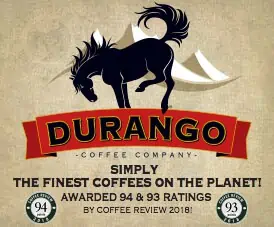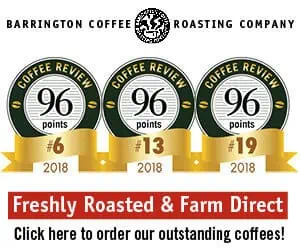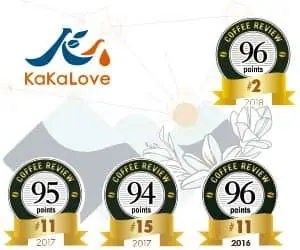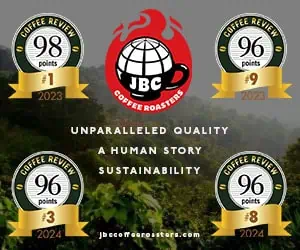To say this coffee has an atypical profile for a Hawaii coffee is an understatement. Comparing it to the other coffees in the cupping is worse than comparing apples and oranges - more like comparing apples and cocker spaniels. The Kaanapali dry-process Moka is, as one panelist called it, a "Yemen wannabe." The trees that produced it are Yemen varietals, and the coffee has been processed in the simple, put-it-out-in-the-sun-to-dry approach used in Yemen and parts of Ethiopia. Which means that, like a Yemen or dry-processed Ethiopia, it is fruity, winy, complex, with a disturbingly lush, overripe aftertaste that lovers of these coffees call gamy or wild and people who don't like Yemen or dry-processed Ethiopia coffees call fermented.Five panelists labeled this coffee fermented and dismissed it with very low scores; three recognized the Yemen/Ethiopia characteristics and treated it like a middle-of-the-road dry-processed Yemen/Ethiopia coffee, giving it scores in the high seventies. Four didn't call it anything but gave it low scores.If this coffee had been presented to the panel in the context of similar dry-processed coffees from Yemen or Ethiopia I don't think it would have provoked quite the same level of criticism. For this reason we're not publishing its scores. However, it did not fare well in the context of this particular cupping.
The clear winner in this cupping, as it was in the 1997 Kona Coffee Cultural Festival Cupping Competition. The reason: it clearly transcends the pleasantly mellow limits of the classic Kona profile. It displayed power, complexity, and an uncompromising, authoritative acidity, laid right on top of the usual soft, brightly sweet virtues of a typical Kona. Even the Kona-bashers on the panel liked this coffee. (Well, all but one.) Nobody raved, but there were lots of approving noises: "excellent," "very interesting, very clean on the palate," "nice depth." However, this excellent coffee might be too authoritative for those who like to slip into the softness of a more typical Kona. Lovers of Kona's sweeter, gentler side may prefer one of the less acidy profiles like the Guyer, Hamasaki, or Bayview Farms mill selections. The rather powerful acidity of this coffee casts doubt on the specialty coffee truism that only high growing altitudes (usually defined as over 4,000 feet) can produce solidly acidy coffees. The average elevation of the Fitzgerald Estate is around 1,600 feet. Apparently microclimate can mimic the conditions that, at higher altitudes, produce acidy profiles.
The Kona song is the same, but this coffee sang it a little stronger and cleaner. No taints or weaknesses whatsoever were cited for this sample. Characterizations of overall flavor, which with the somewhat lower-rated Konas tended to be evenly divided between naysaying "bland" and yeasaying "balanced," here clearly settled on balanced. Occasional little pleasured exclamations turned up on the cupping forms: "very enjoyable"; "the nutty characteristics remained in the cup from beginning to end."
This medium-bodied, fruit-toned coffee attracted strong support from several panelists, who apparently admired its solid acidity, balanced, low-key intensity and fruity nuances. Two panelists detected a faint hardness or bagginess in the aftertaste, although both assigned the coffee respectable scores anyhow.
Several panelists described distinct wine tones, which seemed to be the main nuance that separated this Kona from the others clustered in the middle of the cupping. Otherwise, the familiar Kona profile emerges: bright yet gentle acidity, medium body, balanced flavor, clean aftertaste. Although one panelist felt the coffee generally left a "thin" impression, no taints or weaknesses were cited. In fact, the words "clean" and "fresh" each came up four times in respect to aftertaste.
The majority of panelists who had something to say about this coffee described still another classic Kona: a gentle acidity simultaneously sweet and bright, medium body, soft, balanced cup, clean aftertaste. Fewer grace notes were ascribed to this coffee than to some of the other mid-rated Konas, although this didn't dampen one panelist's ingenuity, who described the aroma as "donuts, [or] fresh-baked sponge-cake." Two dissenting panelists found fault with this coffee, both describing hard tones surfacing in aroma and aftertaste. On the other hand, several went out of their way to describe the aftertaste as "clean."
Majority opinion: Nutty or lightly herbal in the nose, with an acidity both bright and sweet, medium body, flavor nuanced with tones variously described as chocolaty, spicy, or nutty, and a fresh aftertaste. In other words, a classic Kona with dry rather than fruity nuance. One dissenting panelist described the flavor as tinny, and several others ho-hummed their way through the cup without comment. I was impressed by this coffee, particularly by its sweet nuance and what I call dimension -- the way it opened up in repeated little waves of sensation rather than making its statement and standing pat.
The first of four Konas with identical scores of 79 and very similar flavor profiles. Overall assessments of this sample ranged from bland on the downside to balanced on the upside. Which side of the bland/balanced divide panelists settled on probably depended on their predispositions in regard to the Kona profile generally. Three panelists, including me, detected subtle but pleasant wine tones. Three called the acidity sweet, which I assume was praise as well as description. No taints or defects cited; consensus on body: medium.
An interesting coffee that provoked a wide range of reaction. Everyone agreed that it was a soft coffee with medium body. The controversy centered on the flavor complex at the heart of the profile, which elicited characterizations ranging from "delightfully spicy" and "richly chocolaty" to "harsh, burned and disturbing" and "burned seaweed, or something I had in a sushi bar(!)." Scores also varied wildly. The nays didn't outnumber the yeas, but the naysayers nayed with more conviction than the yeasayers yeaed, culminating in a low average score. Readers who like low-acid profiles may want to try this coffee anyhow. At a moderately dark brown or full-city roast I suspect the controversial flavor complex will lose its slightly hard edge and turn definitively complex and rich.
This Kauai peaberry cupped clean for most panelists, although three found a touch of herby or earthy hardness. The main complaint was lack of power: "mellow, well-balanced, [but] almost bland"; "flavor -- still waiting." Five of twelve panelists used the "bland" word. Nevertheless, several identified positive grace notes. "Dark chocolate overtones and very dry," said one.
Two panelists found this coffee pleasantly "soft" and "deep," and several noted dry chocolate or smoke tones. But the majority either yawned or complained of a slight off-taste, variously described as earthy, grassy, herby, or turpenny. Whatever you call it, it dampened an already delicate profile.










